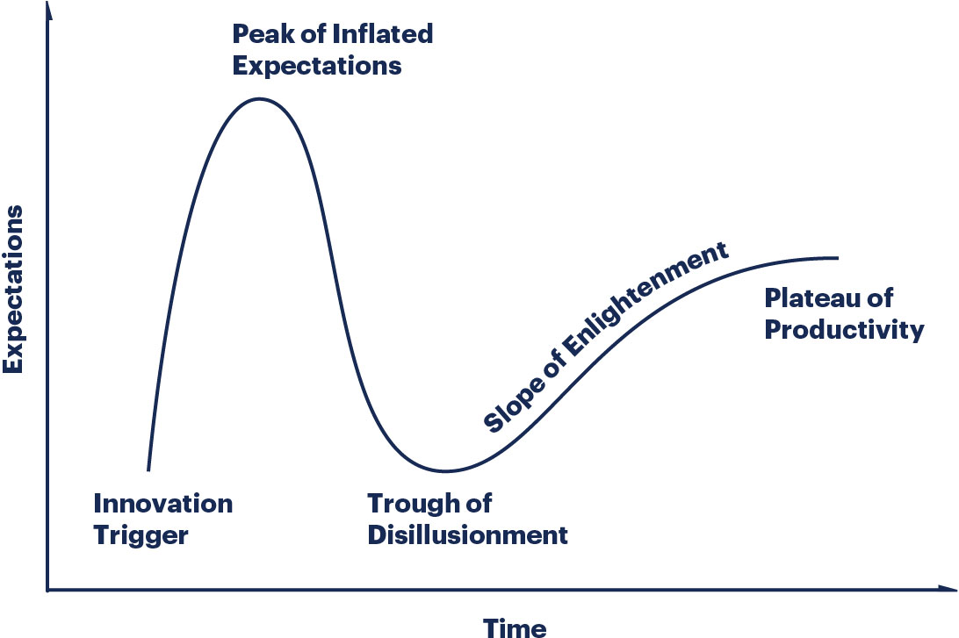If you’ve started exploring AI tools personally (see last week’s post on individual experimentation), you’ve likely experienced Gartner’s “Hype Cycle” firsthand: initial excitement, followed by frustration, then hard-earned clarity about AI’s real potential.

Research from the HBR Guide to Generative AI for Managers confirms what you may already suspect: AI’s greatest value isn’t in basic tasks like search and summarization. It’s in augmenting human capabilities as a thought partner.
Here are three strategies you can use to lead this transformation—especially if you don’t consider yourself an expert:
Strategy 1: Start with Learning Culture

Start by creating psychological safety for AI learning in your team. This means establishing clear guidelines that encourage exploration while managing risks. Model your own AI exploration—both successes and setbacks. When you share, you create space for others to explore and learn.
Create a simple framework for your team to document their experiments: what was tried, what worked, what didn’t, and most importantly, what was learned. This structured approach helps your organization prevent common pitfalls: over-reliance on AI outputs, security risks, and resistance to using AI tools.
Strategy 2: Design for Augmentation

Most organizations are leaving significant value on the table by using AI only to automate basic tasks. To understand why, consider the framework from the HBR Guide that distinguishes between two modes of AI interaction: “Co-Pilot” (executing defined tasks) and “Co-Thinker” (engaging in strategic dialogue and problem-solving).
Let’s call these what they are: automation versus augmentation. While automation streamlines existing processes, augmentation expands human capabilities in unprecedented ways. Automation is teaching AI to follow your existing process; augmentation is partnering with AI to co-create entirely new approaches.
The shift from automation to augmentation is where the real transformation happens. Instead of using AI just to speed up report writing, use it to explore multiple strategic scenarios. Rather than only automating data analysis, engage AI in identifying patterns you might have missed. The possibilities for augmenting human creativity and insight are virtually unlimited.
Strategy 3: Build Systematic Adoption
Research from Exponential Organizations shows that successful AI transformation follows three distinct phases:
- Awake: Help your organization recognize AI’s exponential potential.
- Sprints: Run focused experiments that transform your culture through rapid prototyping.
- Incubate: Develop new approaches by creating small, dedicated teams that can innovate at the edge of your organization.
By implementing this systematic approach, you’ll prevent the scattered adoption that hinders many organizations. You’ll create space for your teams to move beyond basic automation to true augmentation of their capabilities.
Take a page from Apple’s playbook: Form small, innovative teams at your organization’s edge, keep them focused on specific challenges, and then fold successful innovations back into your larger organization.
Building Your AI Learning Culture

These three strategies work together to create sustainable AI adoption. Start with a learning culture that invites (and expects) safe, systematic experimentation. Over time, shift the focus from basic automation to true augmentation of human capabilities. Finally, use the Awake-Sprint-Incubate framework to scale what works across your organization.
As the leader, your goal isn’t to become an AI expert. It’s to create the conditions for those in your organization to move through the hype cycle beyond “slope of enlightenment” to meaningful transformation.
Today, consider:
- Where is your organization in this journey?
- Are you focused on automation when you could be pursuing augmentation?
- What’s one experiment you could run next week to start building a learning culture around GenAI?
